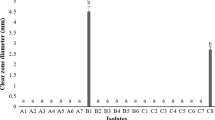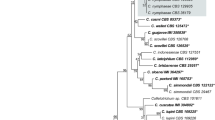Abstract
Colletotrichum gloeosporioides cause citrus anthracnose, is a major threat to citrus quality and fruit production worldwide. In the present study, different experiments were designed to check the potential of various chemicals and biocontrol agents (BCA) against C. gloeosporioides and characterize pathogen from core citrus growing regions of citrus in Punjab, Pakistan. Identification of different pathogens and phylogenetic relationship of Colletotrichum spp. was also performed to examine the relationship between isolates. The phylogenetic relationship determined across 16 C. gloeosporioides isolates showed five distinct clades, highlighting the importance of genetic variation among isolates. Pathogens were identified on the base of the internal transcribed spacers (ITS) region. During survey the disease incidence on fruits and leaves were identified and C. gloeosporioides found to be the most prevalent pathogens. Integrated management was done using BCA (Trichoderma harzianum and T. viride) and the synthetic combined fungicide (Cymoxanil+Mancozeb) under field conditions. Results revealed that, T. harzianum with T. viride and Cymoxanil+Mancozeb gave maximum inhibition against C. gloeosporioides and enhance plant performance under field conditions. In conclusion, the BCA (T. harzianum and T. viride) and the Cymoxanil+Mancozeb could be a better strategy to mitigate the heavy loss of citrus fruit due to anthracnose disease.



Similar content being viewed by others
Change history
13 November 2023
An Erratum to this paper has been published: https://doi.org/10.1007/s10343-023-00944-y
References
Akhtar KP, Alam SS (2002) Assessment keys for some important diseases of mango. Pak J Biol Sci 5(2):246–250
Arshad U, Azeem F, Mustafa G, Bakhsh A, Toktay H, McGiffen M, Nawaz MA, Naveed M, Ali MA (2021) Combined application of biochar and biocontrol agents enhances plant growth and activates resistance against Meloidogyne incognita in tomato. Gesunde Pflanz 73(4):591–601
Cole JT, Cole JC, Conway KE (2005) Effectiveness of selected fungicide applied with or without surfactant in controlling anthracnose on three cultivars of Euonymus fort. J Appl Hort 7(1):16–19
Daoud HB, Baraldi E, Iotti M, Leonardi P, Boughalleb-M’Hamdi N (2019) Characterization and pathogenicity of Colletotrichum spp. causing citrus anthracnose in Tunisia. Phytopathol Mediterr 58(1):175–186
Devi SS, Sreenivasulu Y, Saritha S, Kumar MR, Kumar KP, Sudhakar P (2012) Molecular diversity of native Trichoderma isolates against Fusarium oxysporum f. sp. lycopersici (Sacc.). A causal agent of Fusarium wilt in tomato (Lycopersicon esculentum Mill.). Arch Phytopathol Plant Prot 45(6):686–698
Dukare AS, Paul S, Nambi VE, Gupta RK, Singh R, Sharma K, Vishwakarma RK (2019) Exploitation of microbial antagonists for the control of postharvest diseases of fruits: a review. Crit Rev Food Sci Nutr 59(9):1498–1513
Freeman S, Katan T, Shabi E (1998) Characterization of Colletotrichum species responsible for anthracnose diseases of various fruits. Plant Dis 82(6):596–605
Gunasinghe N, You MP, Barbetti MJ (2016) Phenotypic and phylogenetic studies associated with the crucifer white leaf spot pathogen, Pseudocercosporella capsellae, in Western Australia. Plant Pathol 65(2):205–217
Ha TN (2010) Using trichoderma species for biological control of plant pathogens in Viet Nam. J ISSAAS 16(1):17–21
Haq IU, Sarwar MK, Khan SA, Javed N, Khan NA, Iqbal M, Umar UD (2014) Seedling root rot of rough lemon (Citrus jambhiri Lush) and its chemical management. Pak J Phytopathol 26(2):233–240
Harman GE, Howell CR, Viterbo A, Chet I, Lorito M (2004) Trichoderma species—opportunistic, avirulent plant symbionts. Nat Rev Microbiol 2(1):43–56
Heydari A, Pessarakli M (2010) A review on biological control of fungal plant pathogens using microbial antagonists. J Biol Sci 10(4):273–290
Imran-ul-Haq MS, Khan SA, Jaskani MJ, Ullah Z (2013) Occurrence of guava anthracnose in Punjab (Pakistan) and its integrated management. Pak J Agric Sci 50(4):707–710
Martinez-Culebras PV, Barrio E, Suarez-Fernandez MB, Garcia-Lopez MD, Querol A (2002) RAPD analysis of Colletotrichum species isolated from strawberry and the design of specific primers for the identification of C. fragariae. J Phytopathol 150(11–12):680–686
McGovern RJ, Seijo TE, Hendricks K, Roberts PD (2012) New report of Colletotrichum gloeosporioides causing postbloom fruit drop on citrus in Bermuda. Can J Plant Pathol 34(2):187–194
Meijiao H, Fengzhen Y, Linghong Z, Xiujuan L (2004) Control of postharvest mango diseases with azoxystrobin. Chin J Trop Crop 25(3):37–41
Min YJ, Park MS, Fong JJ, Quan Y, Jung S, Lim YW (2014) Diversity and saline resistance of endophytic fungi associated with Pinus thunbergii in coastal shelterbelts of Korea. J Microbiol Biotech 24(3):324–333
Mohammed AE, You MP, Al-Lami HF, Barbetti MJ (2018) Pathotypes and phylogenetic variation determine downy mildew epidemics in Brassica spp. in Australia. Plant Pathol 67(7):1514–1527
Muthappa BN, Javed ZU, Matiello JB, Mansk Z (2019) Chemical control practices around the world. In: Coffee Rust. CRC Press, Boca Raton, pp 141–160
Nallathambi P, Umamaheswari C, Thakore BB, More TA (2009) Post-harvest management of ber (Ziziphus mauritiana Lamk) fruit rot (Alternaria alternata Fr. Keissler) using Trichoderma species, fungicide and their combinations. Crop Prot 28(6):525–532
O’Callaghan M (2016) Microbial inoculation of seed for improved crop performance: issues and opportunities. Appl Microbiol Biotechnol 100(13):5729–5746
Pérez-Alfonso CO, Martínez-Romero D, Zapata PJ, Serrano M, Valero D, Castillo S (2012) The effects of essential oils carvacrol and thymol on growth of Penicillium digitatum and P. italicum involved in lemon decay. Int J Food Microbiol 158(2):101–106
Rammitsu K, Yagame T, Yamashita Y, Yukawa T, Isshiki S, Ogura-Tsujita Y (2019) A leafless epiphytic orchid, Taeniophyllum glandulosum Blume (Orchidaceae), is specifically associated with the Ceratobasidiaceae family of basidiomycetous fungi. Mycorrhiza 29:159–166
Ramos AP, Talhinhas P, Sreenivasaprasad S, Oliveira H (2016) Characterization of Colletotrichum gloeosporioides, as the main causal agent of citrus anthracnose, and C. karstii as species preferentially associated with lemon twig dieback in Portugal. Phytoparasitica 44:549–561
Seraj SJ (2014) Synthetic plant activators for crop disease management. A review. Int J Th Proj Diss 2:19–28
Shireen F, Jaskani MJ, Nawaz MA, Hayat F (2018) Exogenous application of naphthalene acetic acid improves fruit size and quality of Kinnow mandarin (Citrus reticulata) through regulating fruit load. J Animal Plant Sci 28(4):1080-1084
Smilanick JL, Mansour MF, Gabler FM, Sorenson D (2008) Control of citrus postharvest green mold and sour rot by potassium sorbate combined with heat and fungicide. Post Harv Biol Tech 47(2):226–238
Spadaro D, Gullino ML (2004) State of the art and future prospects of the biological control of postharvest fruit diseases. Int J Food Microbiol 91(2):185–194
Subedi P, Gattoni K, Liu W, Lawrence KS, Park SW (2020) Current utility of plant growth-promoting rhizobacteria as biological control agents towards plant-parasitic nematodes. Plants 9(9):1167
Sundravadana S, Alice D, Kuttalam S, Samiyappan R (2006) Control of mango anthracnose by azoxystrobin. Tunis J Plant Protec 1(2):109
Swart SH, Serfontein JJ, Swart G, Labuschagne C (2009) Chemical control of post-harvest diseases of mango: the effect of fludioxonil and prochloraz on soft brown rot, stem-end rot and anthracnose. IS Acta Horti 820:503–510
Vinale F, Manganiello G, Nigro M, Mazzei P, Piccolo A, Pascale A, Ruocco M, Marra R, Lombardi N, Lanzuise S, Varlese R (2014) A novel fungal metabolite with beneficial properties for agricultural applications. Molecules 19(7):9760–9772
Vu TX, Tran TB, Hoang CQ, Nguyen HT, Do LM, Dinh MT, Thai DH, Tran TV (2021) Potential of Trichoderma asperellum as a biocontrol agent against citrus diseases caused by penicillium digitatum and Colletotrichum gloeosporioides. Int J Agric Technol 1:2005–2020
Watanabe M, Lee K, Goto K, Kumagai S, Sugita-Konishi Y, Hara-Kudo Y (2010) Rapid and effective DNA extraction method with bead Grindingfor a large amount of fungal DNA. J Food Prot 73(6):1077–1084
Zeming D, Meijiao H, Zhang YF, Xiujuan LL (2003) Effect of amistar on controlling of mango anthracnose. Chin J Trop Crop 14:624–631
Zhong G, Nicolosi E (2020) Citrus origin, diffusion, and economic importance. In: Citrus genome, pp 5–21 https://doi.org/10.1007/978-3-030-15308-3_2
Zhou Y, Li S, Zeng K (2016) Exogenous nitric oxide-induced postharvest disease resistance in citrus fruit to Colletotrichum gloeosporioides. J Sci Food Agric 96(2):505–512
Acknowledgements
The authors would like to thank Department of Horticulture and Department of Plant Pathology, Punjab University Lahore for providing antagonistic fungi and the necessary materials to carry out the study.
Author information
Authors and Affiliations
Contributions
IN performed the experiments, analyzed the data and prepared the original manuscript. NJ and SAK contributed to supervision, editing, conceptualization, analyzing and interpretation of the data. MA performed the statistical analysis. All the authors also contributed to reviewing and editing of the manuscript. All authors read and approved the final manuscript.
Corresponding author
Ethics declarations
Conflict of interest
I. Naeem, N. Javed, S.A. Khan and M. Abbas declare that they have no competing interests.
Additional information
The original online version of this article was revised: In this article, the affiliation details for Mazhar Abbas were incorrectly given as follows:
2 Department of Horticulture, University of Agriculture Faisalabad, Faisalabad, Pakistan
3 Department of Horticulture, Karachi University, Karachi, Pakistan
However, in the article, the affiliation details should have read as follows:
2 Institute of Horticultural Sciences, University of Agriculture Faisalabad, Faisalabad, Pakistan
3 Department of Agriculture and Agribusiness Management, Faculty of Science, University of Karachi, Karachi – 75270, Pakistan
Rights and permissions
Springer Nature or its licensor (e.g. a society or other partner) holds exclusive rights to this article under a publishing agreement with the author(s) or other rightsholder(s); author self-archiving of the accepted manuscript version of this article is solely governed by the terms of such publishing agreement and applicable law.
About this article
Cite this article
Naeem, I., Javed, N., Khan, S.A. et al. Application of Mixtures of Chemical and Biocontrol Agents Against Anthracnose (Colletotrichum gloeosporioides) of Citrus and Pathogen Variability in Local Zone. Gesunde Pflanzen 75, 2281–2289 (2023). https://doi.org/10.1007/s10343-023-00926-0
Received:
Accepted:
Published:
Issue Date:
DOI: https://doi.org/10.1007/s10343-023-00926-0




